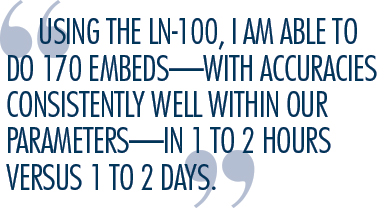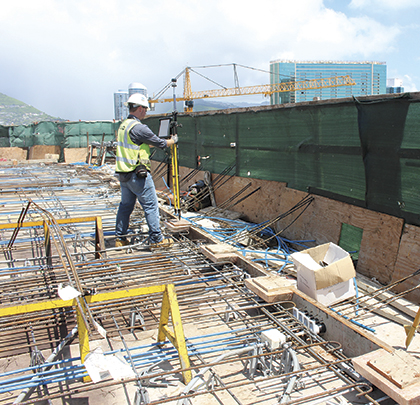Nordic PCL is the prime contractor on the Waiea tower, a 38-story structure that will be home to 171 ultra-luxury condominiums as part of the Ward Village planned community. Located in the Kakaako section of downtown Honolulu, one of the tower’s signature features is a unique, simulated wave, glass curtain wall consisting of more than 600 panes—each different from the other—which runs the full length of the east-facing wall.
CHALLENGE
To secure the curtain wall to the structure itself, every pane on the Waiea feature must tie in to any of a variety of embeds attached to each floor’s post-tensioned slabs. On any given floor there can be as many as 320 embeds and Nordic PCL needed to ensure that each embed was in the precise position to mate with what the glass supplier had provided. Should the embed be out of position, the contractor would be forced to take the time to do a costly, time-consuming rework to make that structural connection happen. According to Thane Werner, Nordic PCL’s field engineer, however, performing a manual layout for each of the embeds was proving extremely cumbersome.
“We were pulling tape from two different dimensions and setting up offsets,” says Werner. “I was out there all day, every day, pulling tape from gridlines to make sure each of those locations was correct. At the outset of the project, we were only doing half of the structure at a time—about 170 embeds on each floor—and that was taking us about 2 days. Looking at the task ahead, I felt there had to be a better way to do this.”

Featured Image: To secure the curtain wall to the structure itself, every pane on the Waiea feature must tie in to any of a variety of embeds attached to each floor’s post-tensioned slabs.
Above: Nordic PCL is the prime contractor on the Waiea tower, a 38-story structure featuring a curved glass wall that will be home to 171 ultra-luxury condominiums as part of the Ward Village planned community.
SOLUTION
About that time, Werner had seen a YouTube video of PCL using the Topcon LN-100 Layout Navigator and, upon seeing it, immediately felt that it could be the way to save a good deal of layout time.
“If what I was seeing was correct, instead of having to pull tape we could simply set up this 3D positioning instrument and verify that all these locations were correct,” he says. “So I spoke to one of my managers and told him I felt we should look into this technology. My rationale was simple: By using it, we would be able to quickly and accurately ensure that every embed is in the correct location, eliminating the need to chip away at the slab and reposition wrongly-placed embeds—and the costs associated with doing so.”
Werner’s pitch was accepted and they were soon talking to Asa Kaneko, from RDO Integrated Controls, the Topcon dealer on Hawaii’s Big Island, who set them up with an LN-100 Layout Navigator. According to Werner, despite having no prior experience with survey equipment, he found the Topcon unit to be almost self-operating.
“It was extremely simple to use,” he says. “It is a self-leveling instrument and operated in conjunction with an iPad-driven Autodesk BIM 360 Layout app which connects to the LN-100 via wi-fi. Once it was up and running, I was able to take a re-section and, running off the 3D model on the iPad, was able to see, in real time, where my prism rod was in relation to the LN-100. From there, I simply verified my points and we were in business.”

RESULTS
The level of productivity using the Topcon LN-100 was nothing short of amazing, according to Werner. To reiterate: In the past, Nordic PCL was taking roughly a day and a half to two days to obtain 170 points.
“Using the LN-100, I am able to do that same number of embeds—with accuracies consistently well within our parameters—in anywhere between 1 and 2 hours,” says Werner. “That’s an impressive turnaround that’s made even better in knowing we’ve all but eliminated any rework costs. Right now, The Topcon unit is only being used on the Waiea project, but we can see it being used to verify pipe, floor layouts, wall layouts, any kind of MEP (mechanical, electrical, plumbing) layout, and so on. We already have other field engineers who have expressed interest in using it, so we’re pretty certain it will have a place in our everyday use.” ■
About the Author: Larry Trojak is president of Trojak Communications, a Minnesota-based marketing communications firm. He has written for the construction, recycling, demolition, scrap, and aggregate processing industries.
_________________________________________________________________________
Modern Contractor Solutions – February 2016
Did you enjoy this article?
Subscribe to the FREE Digital Edition of Modern Contractor Solutions magazine.

170 Points of Accuracy


